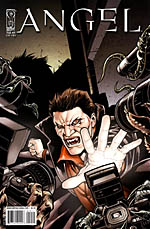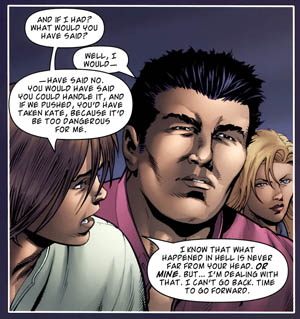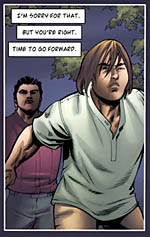 Written by Kelley Armstrong
Written by Kelley Armstrong
Penciled by Dave Ross
Inked by George Freeman and Dave Ross
32 pages, color
Published by IDW
With the wild success (both creatively and financially) of Dark Horse’s Buffy the Vampire Slayer: Season Eight, it makes perfect sense that we’d see the same thing for Buffy spin-off show Angel. IDW’s Angel: After the Fall got to explore the entire city of Los Angeles being sent to Hell as a direct result of the end of the Angel television series; now that Los Angeles is back on Earth, the After the Fall subtitle is gone but the comic is continuing. With a new creative team on board, it seemed like a good a time as any to check the title out.
 Being a hero, it seems, is really just another name for having a big target plastered on your back. Now that everyone—both good and evil—knows that Angel was responsible for saving all of Los Angeles from being trapped in Hell for all eternity, everyone wants a piece of him. Some are looking for help, others for revenge. When an assassin offers Angel a way to get the bad guys off of his back, it seems like something that’s too good to be true. Problem is, that may very well be the case. And can Angel really re-form Angel Investigations with an entirely different group of people, or is he making a big mistake this time around?
Being a hero, it seems, is really just another name for having a big target plastered on your back. Now that everyone—both good and evil—knows that Angel was responsible for saving all of Los Angeles from being trapped in Hell for all eternity, everyone wants a piece of him. Some are looking for help, others for revenge. When an assassin offers Angel a way to get the bad guys off of his back, it seems like something that’s too good to be true. Problem is, that may very well be the case. And can Angel really re-form Angel Investigations with an entirely different group of people, or is he making a big mistake this time around?
As someone who hadn’t read Angel: After the Fall up until now, Angel #19 was ultimately an all right if not overwhelming experience. Novelist Kelley Armstrong’s writing is definitely the stronger half of the equation here, as she assembles a group of characters that are both brand new as well as borrowed from the supporting cast of the original show. It’s not a bad idea, and having Angel operating in plain sight is being used surprisingly well; Armstrong takes it to its logical conclusion, with both the government and the people of Los Angeles all turning to Angel for their various needs and requests. On the down side, though, it’s actually a little hard to care about a lot of these characters; none of the characters seem to really have their own distinct voice, and it’s hard to get a real grasp on them beyond the most superficial means. More importantly, aside from reacting to events, Angel seems to be lacking a distinct plot. I’ve yet to feel (two issues into Armstrong’s run) like there’s any sort of drive or overarching idea going on here. It’s something that seems to have at least temporarily fallen by the wayside along with the "After the Fall" subtitle, and I think it’s something that needs to be regained swiftly.
 Dave Ross’s pencils are uncharacteristically not like his normal art, but unfortunately not in a good way. I’m not entirely sure what’s going on here with the likenesses of various characters, but they all seem off and out of kilter. Characters’s eyes are continually narrowed into thin slits, Angel’s face looks so puffy it makes me wonder if there’s a missing narration box about him eating blood flavored with lard, and Connor looks continually constipated at best. Even once you get past the likenesses, though, it’s not a very well-drawn book. When Angel introduces Dez to the rest of the group, for instance, he’s apparently staring at the ceiling for no particular reason. Kate’s midriff-baring police uniform is the most ludicrous thing I’ve seen in a while, and that’s in a book where all three major female characters have their bellies exposed for some or all of the comic. Even the coloring seems askew; there’s one part where a cat is walking out of the shadows into the light and I honestly thought at first that it was half-leopard, half-panther and it took several glances to figure out that the "panther" half was really supposed to be shadow.
Dave Ross’s pencils are uncharacteristically not like his normal art, but unfortunately not in a good way. I’m not entirely sure what’s going on here with the likenesses of various characters, but they all seem off and out of kilter. Characters’s eyes are continually narrowed into thin slits, Angel’s face looks so puffy it makes me wonder if there’s a missing narration box about him eating blood flavored with lard, and Connor looks continually constipated at best. Even once you get past the likenesses, though, it’s not a very well-drawn book. When Angel introduces Dez to the rest of the group, for instance, he’s apparently staring at the ceiling for no particular reason. Kate’s midriff-baring police uniform is the most ludicrous thing I’ve seen in a while, and that’s in a book where all three major female characters have their bellies exposed for some or all of the comic. Even the coloring seems askew; there’s one part where a cat is walking out of the shadows into the light and I honestly thought at first that it was half-leopard, half-panther and it took several glances to figure out that the "panther" half was really supposed to be shadow.
The end of Angel #19 gives some small hope that Armstrong is going somewhere with her storyline, and I hope that’s the case. Right now, it feels like Angel exists solely because Angel: After the Fall was a huge sales success, not because there’s a great new story dying to be told. Hopefully they can find the latter before too much longer.
